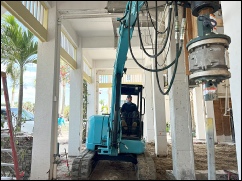

Copyright © 2011-25 Helical Pile World, LLC. All Rights Reserved.
Home | Engineers | Manufacturers | Installation Contractors | News | Technical Advisors | Contact Us







 Helical Pulldown Micropiles were specified for this project due to poor soil conditions after the crew installed a few piles to 60-70 feet with poor compressive capacity averaging only 1,700 ft. lbs. of torque or 8.5 tons of capacity.
Helical Pulldown Micropiles were specified for this project due to poor soil conditions after the crew installed a few piles to 60-70 feet with poor compressive capacity averaging only 1,700 ft. lbs. of torque or 8.5 tons of capacity.
The Helical Pulldown Micropiles had a 5” grout column surrounding the length of the extensions (the lead with helixes is not grouted). The addition of the grout column increases the capacity of the helical pile by 600 to 1000 Kips per vertical foot.
The Coastal Foundation Solutions crew installed designated pilings on both the interior and exterior of the residence. The project design originally contained underpinning pilings around the perimeter of the structure. However, onsite excavations to locate the footer were only preformed to two foot beneath grade. The architect elected to install new foundation piles instead of underpinning piles on the perimeter grade beam.
Poor Site Conditions
The crew encountered flowing ground water beneath the footing, and this required (22) hours of excavating and de-watering.
New Foundation (Interior)
Installed (20) SS150 RCS 76” leads with 8” x 10” x 12” helixes. (2) of the piles encountered refusal at 18 feet.
New Foundation (Exterior)
Installed (28) SS150 RCS 76” leads with 8” x 10” x 12” helixes. (12) of the piles encountered refusal at 18 feet.
“Refusal” or “Spin-out” of a helical pile occurs when the pile refuses to penetrate while continuing to rotate during installation. Spin-out can occur when the soil’s resistance to penetration exceeds the downward thrust generated by the helix plates and the crowd pressure applied by the 28,000 Lb. excavator. Spin-out usually occurs at the conversion between a dense soil layer and bedrock when the helix plates confront hard/very dense material. Helical pile spin-out (refusal) affects the load capacity, and the means to predict said capacity via torque correlation. Once the helical pile tip (3.5” Diameter) encounters lime rock, the installation torque can no longer be computed. The digital torque indicator may only record as the helical pile is progressing and creating torque resistance. Therefore, the bearing capacity of spin-out piles can only be determined definitively with an actual static load test. When the helical pile has spun-out on bedrock, the capacity can be assumed to be limited to the structural strength of the bottom-most helix plate – assuming the bedrock is strong enough to bear the load. In this representation, the lower most helix plate reflects the following design perimeters.
Coastal Foundation Solutions Installs (48) Helical Pulldown Micropiles on a Large House in Bonita Springs, FL
Spring, 2023
by Olivia Normandin


Coastal Foundation Solutions, LLC
P.O. Box 248 Matlacha, FL 33993
Servicing Southwest Florida
(239) 336-4112 www.CoastalFoundationSolutions.com